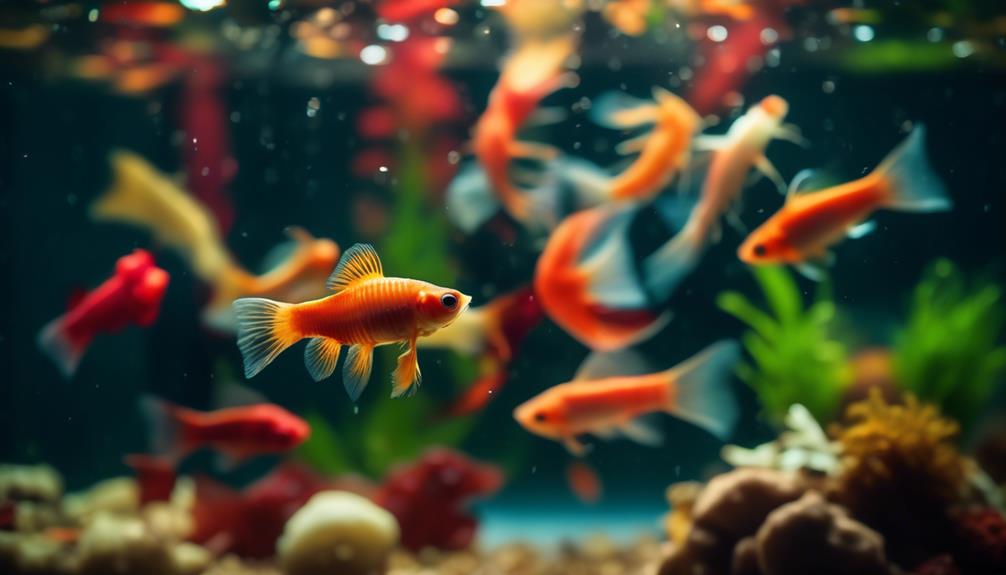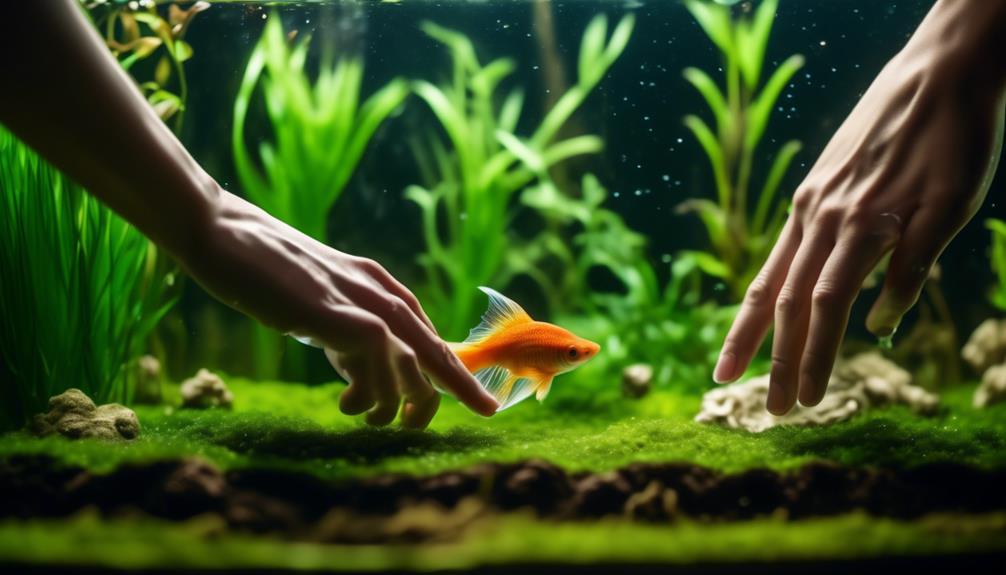Platy fish, with their vibrant colors and livebearing nature, have captivated the attention of freshwater aquarium enthusiasts. Originating from Mexico and Central America, these fascinating creatures offer a wide range of color variations, thanks to their ability to crossbreed with other platy species and even swordtails.
In this comprehensive article, we will explore the art of platy fish care, focusing on essential aspects such as feeding, breeding, and maintaining tank harmony. By understanding their dietary needs, ensuring successful reproduction, and creating a compatible community, you can provide these peaceful and easy-to-care-for fish with the ideal environment to thrive.
So, let's embark on this journey into the world of platy fish care and unlock the secrets to mastering their art.
Key Takeaways
- Platies are popular livebearers that come in various color variations.
- They can be kept in a 10-20 gallon aquarium or larger, with a preference for harder water.
- Platies should be fed a diverse diet of high-quality flakes, pellets, and frozen foods.
- Breeding platies is relatively easy, but providing cover and hiding places for fry is important for their survival.
Platy Fish Types and Tank Setup
When it comes to Platy fish types and tank setup, it is important to consider their origin, species variations, and the appropriate aquarium conditions to ensure their well-being.
Platy fish are native to Mexico and Central America, with the two most common species being Xiphophorus maculatus and Xiphophorus variatus. These species can crossbreed with each other and with swordtail species, resulting in various color variations. Some popular varieties of platies include Mickey Mouse, sunburst, red wag, blue, bumblebee, and green lantern platies.
When choosing the right tank size for platy fish, a 10-20 gallon aquarium or larger is recommended. Platies can tolerate a wide pH range from 6.8-8.5 and prefer harder water, so mineral supplements may be necessary.
Providing a suitable tank setup that replicates their natural habitat is crucial for the well-being of platy fish.
Platy Fish Care and Compatibility
Platy fish care and compatibility require careful consideration of their specific needs and suitable tank mates to ensure their well-being in the aquarium. When selecting tank mates for platy fish, it is important to choose species that share similar water conditions and temperament. Here are some ideal tank mates for platy fish:
| Tank Mates | Ideal Water Conditions | Temperament |
|---|---|---|
| Small Tetras | pH 6.8-8.5, 70-82°F | Peaceful |
| Rasboras | pH 6.8-8.5, 70-82°F | Peaceful |
| Cory Catfish | pH 6.8-8.5, 70-82°F | Peaceful |
| Snails | pH 6.8-8.5, 70-82°F | Peaceful |
| Plecos | pH 6.8-8.5, 70-82°F | Peaceful |
| Rainbowfish | pH 6.8-8.5, 70-82°F | Peaceful |
These tank mates will coexist harmoniously with platy fish, creating a peaceful and balanced community aquarium. It is essential to maintain the ideal water conditions for platy fish, including a pH range of 6.8-8.5 and a temperature between 70-82°F. Regular water testing and appropriate adjustments should be made to ensure the well-being of all inhabitants. By selecting compatible tank mates and providing optimal water conditions, you can create a thriving and harmonious aquarium for your platy fish.
Platy Fish Diet

A well-balanced and nutritious diet is crucial for the optimal health and vitality of platy fish in the aquarium. Platies are omnivores and will eat a variety of foods, so it's important to provide them with a diverse diet. This should include high-quality flakes, pellets, freeze-dried and frozen foods. It is also beneficial to include proteins, vegetables, algae, vitamins, and minerals in their diet.
Feeding frequency is an important consideration as well. Adult platies can be fed once a day, while juveniles prefer 2-3 small meals. It's important to avoid overfeeding, as it can lead to long strings of poop and health issues.
Offering a varied diet not only ensures that platies receive all the necessary nutrients, but it also helps to stimulate their natural foraging behaviors. By providing a well-rounded diet, you can help to maintain the overall health and well-being of your platy fish.
Breeding and Reproduction of Platy Fish
The breeding and reproduction of platy fish is a fascinating process that showcases their unique livebearing nature. Breeding techniques for platy fish are relatively simple, as they are prolific breeders. To encourage breeding, it is important to have a ratio of at least two females to every male.
Female platies can give birth to as many as 20-50 babies per month, so providing cover and hiding places is essential to increase fry survival rate. Adult platies show no parental care and may even eat their own fry, so it is crucial to separate the fry from the adults or provide plenty of hiding spots.
Once the fry are born, they can be fed finely crushed flakes or specialized fry food to ensure their proper growth and development. With proper care, platy fish breeding can be a rewarding and enjoyable experience.
Additional Care Tips and Information

To ensure the optimal health and well-being of your platy fish, it is important to follow these additional care tips and have access to valuable information:
- Importance of water quality in platy fish care:
- Regularly test the water parameters such as ammonia, nitrite, and nitrate levels to maintain a healthy environment.
- Perform regular water changes to remove accumulated toxins and maintain proper pH levels.
- Use a reliable filtration system to keep the water clean and provide oxygenation.
- Tips for maintaining a healthy platy fish tank environment:
- Provide ample hiding places and plants for the platies to feel secure and reduce stress.
- Ensure proper lighting conditions by using a timer to mimic their natural day-night cycle.
- Avoid overcrowding the tank to prevent aggression and stress among the fish.
Frequently Asked Questions
How Do You Sex Platy Fish?
To determine the sex of platy fish, observe their physical characteristics. Males have a gonopodium, a modified anal fin used for reproduction, while females have a larger and rounder body shape. Breeding strategies for platy fish involve maintaining a proper male-to-female ratio and providing suitable conditions for reproduction.
Can Platy Fish Be Kept With Aggressive Fish Species?
Keeping platy fish with aggressive species can be risky. While platies are generally peaceful, aggressive tank mates may stress and harm them. It is best to choose compatible tank mates like small tetras, rasboras, cory catfish, snails, plecos, and rainbowfish for a harmonious tank environment.
What Is the Lifespan of a Platy Fish in Optimal Conditions?
The lifespan of a platy fish in optimal conditions can range from 2 to 4 years. Factors such as proper care, diet, water quality, and tank environment play crucial roles in determining the longevity of platy fish in an aquarium.
How Can I Prevent Platies From Eating Their Fry?
To prevent platies from eating their fry, you can employ fry separation techniques such as using a breeding box, floating plants, or a separate nursery tank. These methods provide hiding places for the fry, minimizing the chances of cannibalism.
Are There Any Specific Water Parameters That Platy Fish Require for Optimal Health and Breeding Success?
In order to promote optimal health and breeding success in platy fish, it is important to maintain appropriate water parameters. This includes ensuring high water quality and providing a suitable tank size to accommodate their needs.
Conclusion
In conclusion, mastering the art of platy fish care involves understanding their dietary needs, creating a suitable tank environment, and ensuring successful breeding and reproduction.
With proper attention and maintenance, these vibrant and easy-to-care-for fish can thrive for 2-4 years, bringing beauty and vitality to any aquarium.
By following the guidelines outlined in this comprehensive article, you can provide the ideal conditions for your platy fish and enjoy their captivating colors and livebearing nature.
Dive into the world of platy fish care and create a harmonious and thriving aquatic community.

